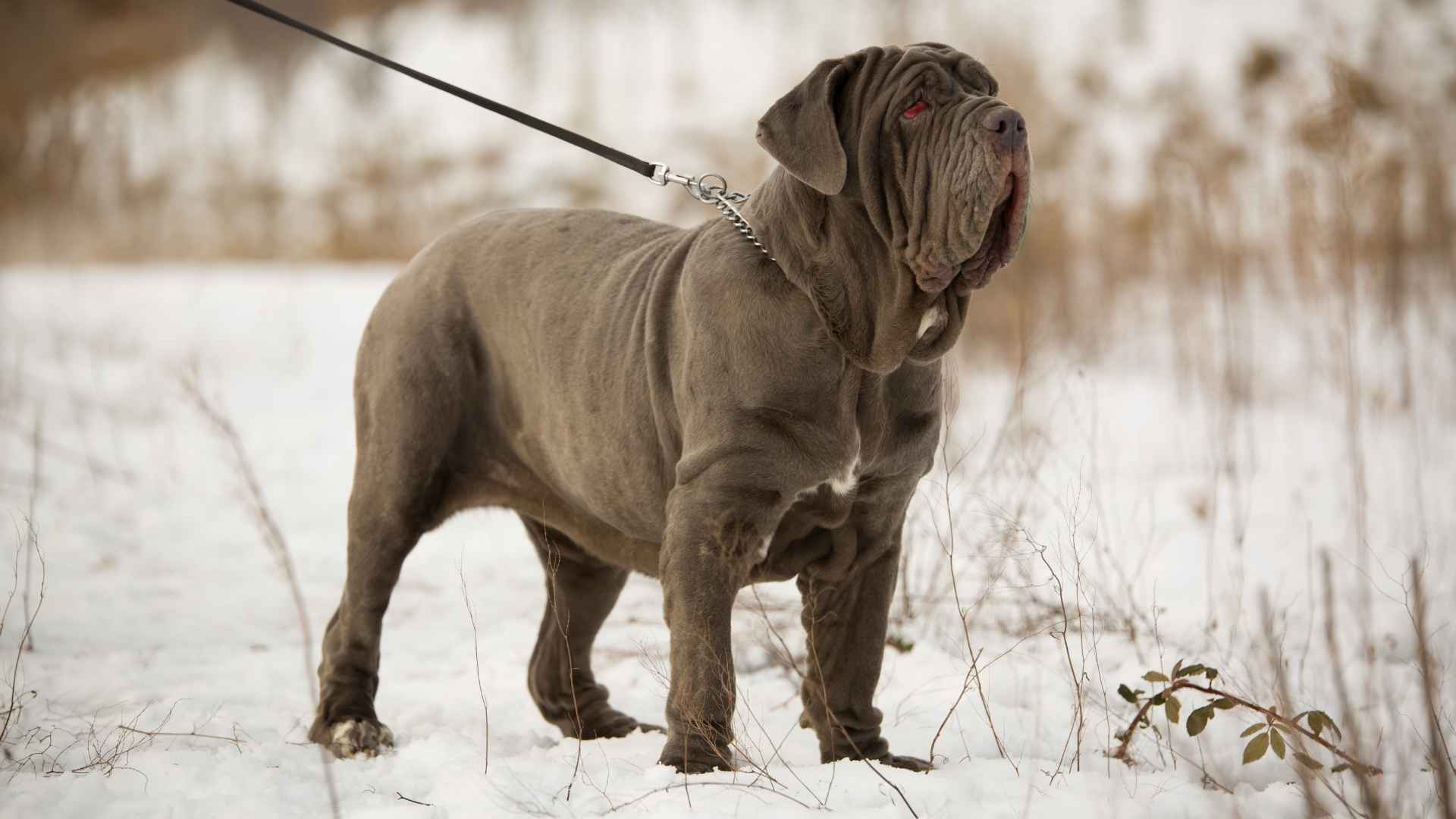Dogs have an incredible way of touching our hearts—loyal, loving, and endlessly expressive, they fill our homes with joy and laughter. Among the countless breeds that exist today, some are so rare that even lifelong dog lovers may have never heard of them.
These unique canines are often prized for their striking appearances, fascinating origins, and one-of-a-kind personalities that set them apart from the usual household favorites.
But what makes some of these rare breeds even more extraordinary is their shorter lifespan. According to the American Kennel Club, giant breeds have an average life expectancy of only 8 to 10 years. Even though their lives may be shorter, their impact lasts a lifetime.
In this article, we’ll explore the rare and wonderful dog breeds with the shortest life expectancy that capture hearts with their beauty, devotion, and charm. Each one has a story worth knowing and a presence impossible to forget.
Key Takeaways
Meet amazing, rare giants like the Dogue de Bordeaux, Irish Wolfhound, and Leonberger.
Discover the fascinating past of loyal protectors like the Neapolitan Mastiff, Presa Canario, and Scottish Deerhound.
Find out why gentle breeds such as the Greater Swiss Mountain Dog don’t live as long—and how love and care make every year count.
Explore what makes these powerful pups so special, from their courage to their unshakable devotion.
Rare and Wonderful Short-Lifespan Dog Breeds
1. Dogue de Bordeaux
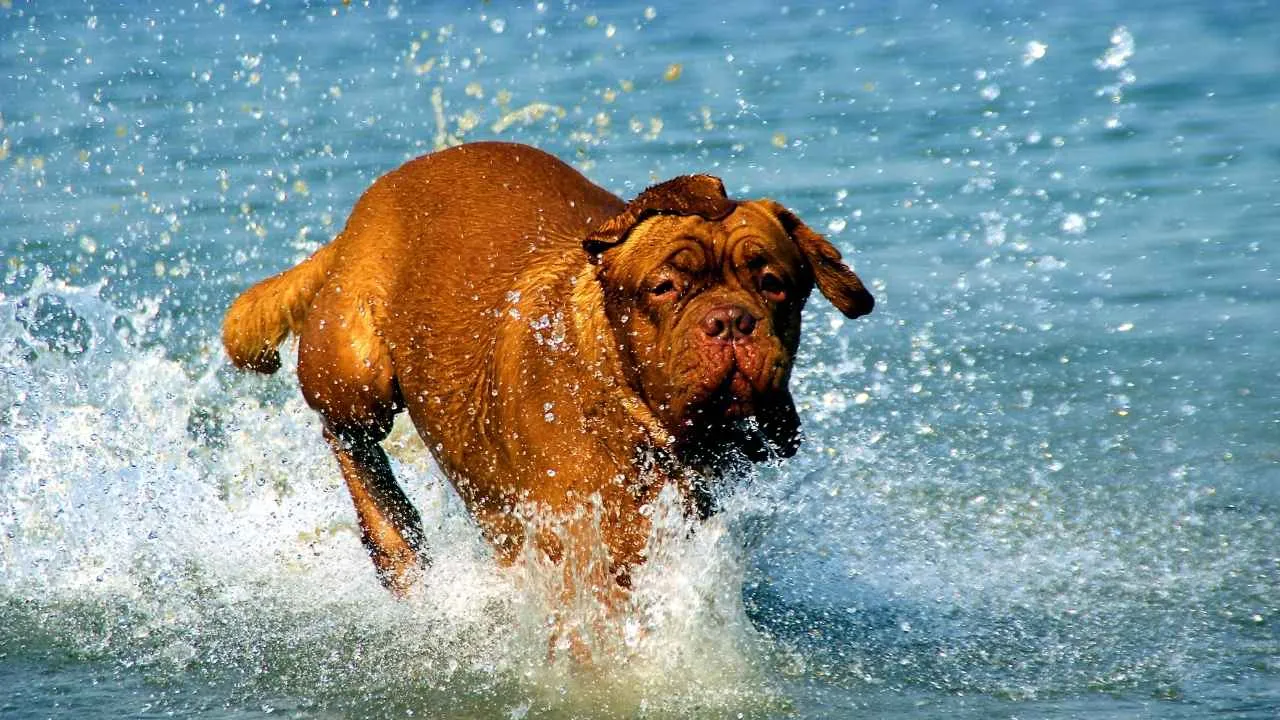
The Dogue de Bordeaux, or French Mastiff, is among France’s oldest dog breeds, around even before the nation itself. Originating in the 14th century, it worked as a fearless guardian of estates, protector of livestock, and hunting partner.
Though nearly wiped out during the French Revolution, this powerful breed endured and remains a symbol of loyalty and strength.
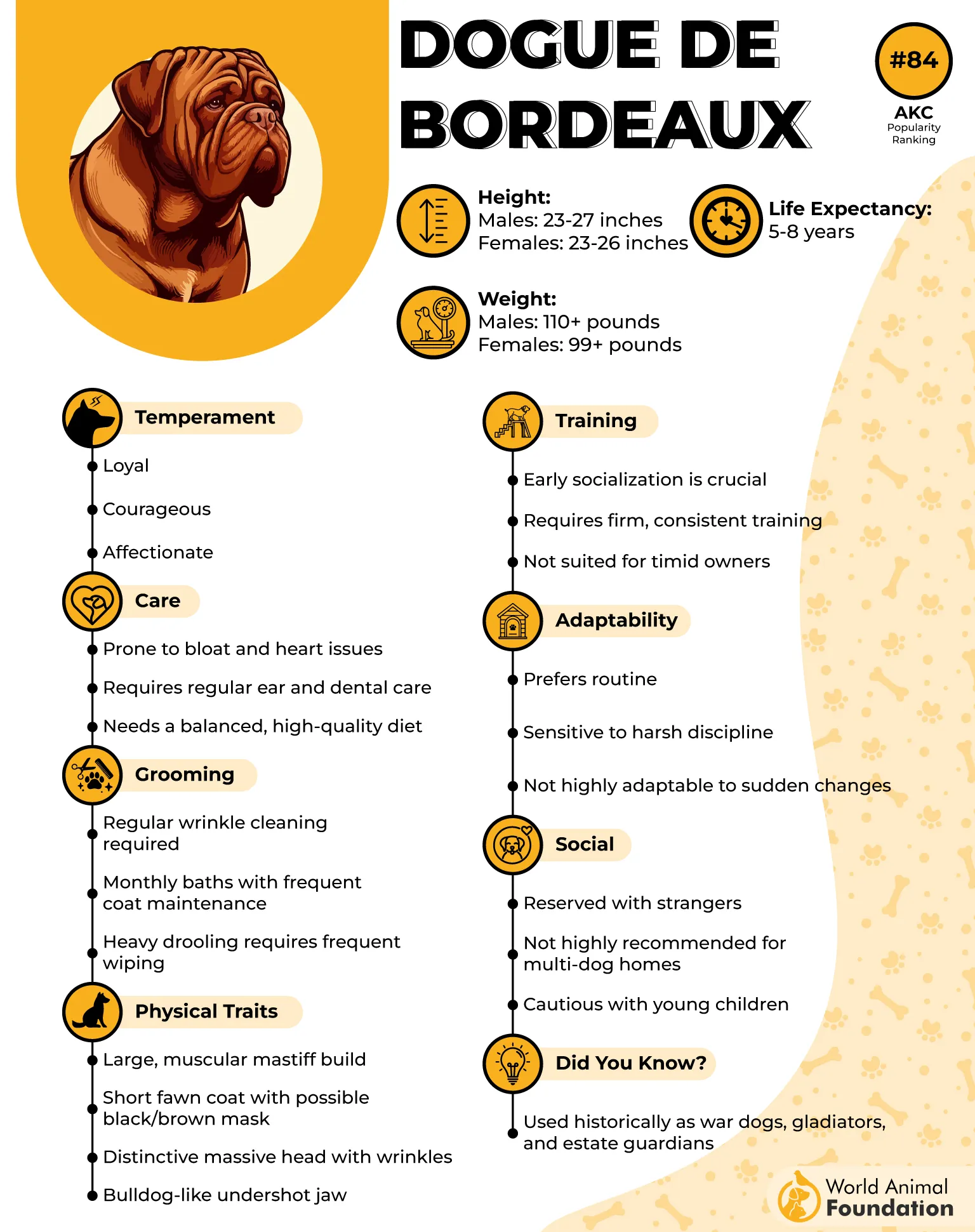
Appearance and Personality
The Dogue de Bordeaux is an unmistakable breed, known for its powerful, muscular frame and distinctive fawn-colored coat. Its massive head, deeply wrinkled brow, and soulful eyes give it an expression that is both commanding and affectionate.
Despite its imposing size, the Dogue de Bordeaux is gentle and deeply loyal to its family.
It forms strong emotional bonds and thrives on companionship. While naturally protective, it is not aggressive when properly trained and socialized. This breed combines courage with sensitivity—devoted, affectionate, and always eager to please those it loves most.
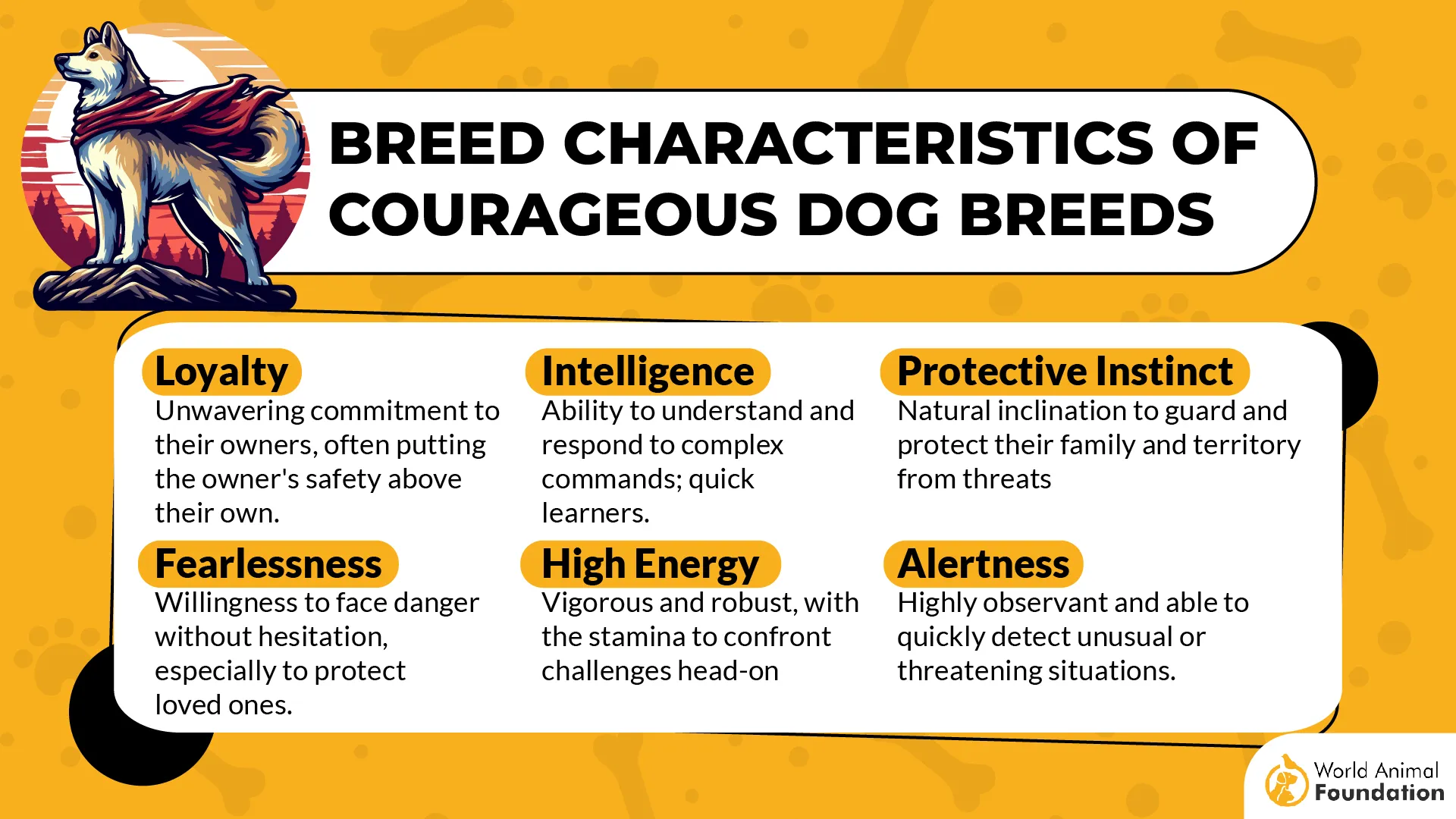
Health and Rarity
The Dogue de Bordeaux is considered a rare and ancient breed, known for its massive strength and deep devotion—but also for its shorter lifespan, typically around five to eight years, as mentioned by PetMD.
Because of their large frames, these dogs can face various health problems. Responsible breeders and pet parents play a big role in keeping them healthy and comfortable.
Common health concerns include:
Hip and Elbow Dysplasia
Bloat (Gastric Dilatation-Volvulus)
Footpad Hyperkeratosis
Eye Conditions (Ectropion and Entropion)
Skin Issues
Respiratory and Breathing Problems
With attentive care, regular veterinary care, and a proper diet, this rare French mastiff can live a full and loving life—short but filled with loyalty, courage, and heart.
2. Neapolitan Mastiff
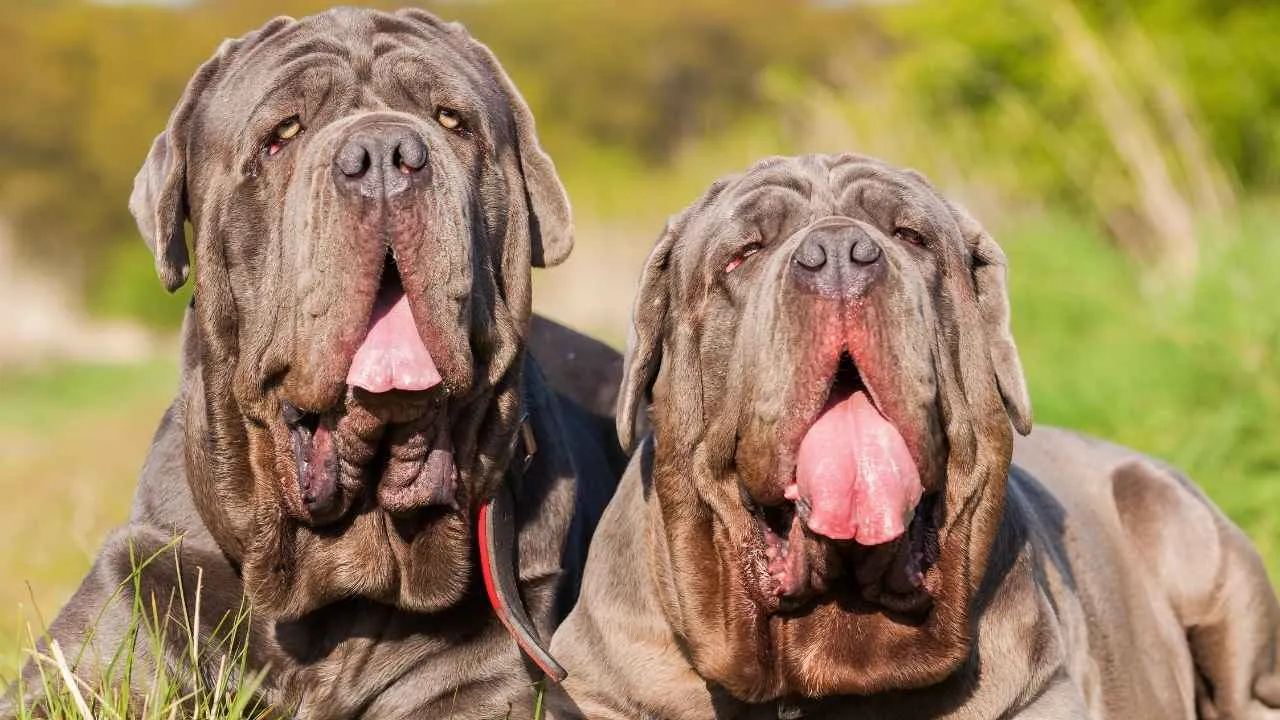
The Neapolitan Mastiff, also called the Mastino, is one of Italy’s most ancient dog breeds. Originally bred in southern Italy, these massive dogs once fought alongside Roman soldiers and guarded estates across the countryside.
Over time, their role changed from war dogs to loyal family protectors. Despite their intimidating looks, Neapolitan Mastiffs are known for their calm nature and deep loyalty to their families.

Appearance & Personality
The Neapolitan Mastiff is famous for its loose, wrinkled skin, hanging lips, and dignified presence. Its short, dense coat has a natural sheen that gives the Mastino a majestic yet rugged appearance.
Despite its massive build, this breed embodies the perfect balance of power and gentleness—a true “gentle giant.” Loyal and protective, the Neapolitan Mastiff is deeply devoted to its family and naturally cautious around strangers.
Calm and affectionate by nature, it enjoys spending quiet time with its loved ones and thrives in peaceful surroundings.
Health and Rarity
The Neapolitan Mastiff is a rare, ancient breed known for its massive size and average lifespan of only seven to nine years.
Because of its build and genetics, the Mastino can be prone to several health issues. Responsible breeding and early veterinary care are vital to keeping them healthy and comfortable.
Common health problems include:
Heart Disease (Dilated Cardiomyopathy)
Allergies and Skin Irritation
Gastric Dilatation and Volvulus (Bloat)
Hip and Elbow Dysplasia
Cherry Eye
Although their lives may be shorter, Neapolitan Mastiffs leave an unforgettable mark of devotion and quiet strength, embodying both the grandeur and tenderness of Italy’s most ancient guardian.
3. Irish Wolfhound
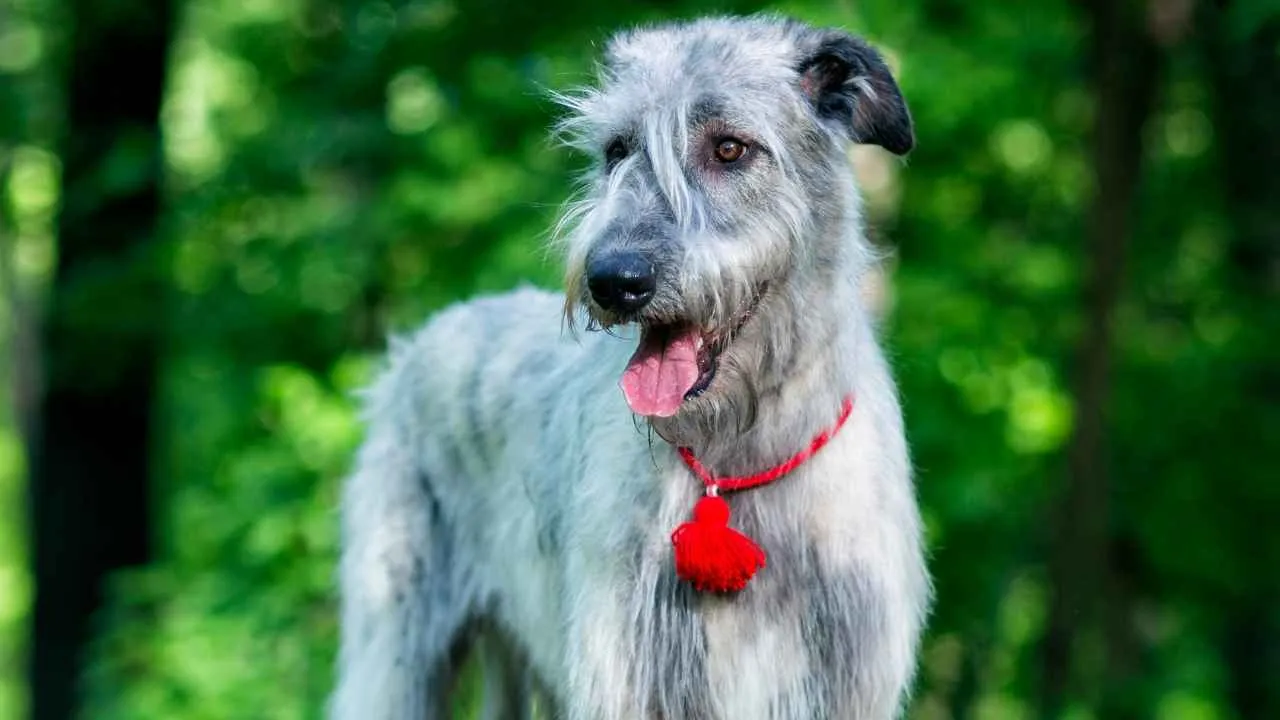
The Irish Wolfhound is one of the oldest and most noble dog breeds in the world. Originally bred in Ireland, these giant hounds were used to hunt wolves, elk, and even to assist in battles, as noted by Britannica.
Once considered symbols of honor and status, Irish Wolfhounds were owned only by kings and nobles. Though they were once fierce hunters, today they are calm, gentle companions admired for their grace, loyalty, and gentle spirit.

Appearance and Temperament
Britannica mentions that the Irish Wolfhound is recognized as the tallest of all dog breeds, with a powerful, muscular build and a rough, wiry coat that comes in shades of gray, brindle, black, and fawn. Despite their impressive stature, they are remarkably gentle and affectionate.
They are patient and kind with children, loyal and calm around family, and brave yet peaceful in nature. Their size alone deters intruders, but aggression is rare in this noble breed. They embody quiet strength and a calm temperament that make them truly special companions.
Health and Rarity
The Irish Wolfhound is a rare and ancient breed, known for its size, strength, and gentle nature. However, their large build contributes to several health risks and a naturally shorter life expectancy.
Common health concerns include:
Gastric Dilatation-Volvulus (Bloat)
Bone Cancer (Osteosarcoma)
Hip Dysplasia
Elbow Dysplasia
Dilated Cardiomyopathy (DCM)
With proper care, regular veterinary attention, and a healthy lifestyle, Irish Wolfhounds can live their years in comfort and companionship, embodying both the power and tenderness of Ireland’s most iconic hound.
4. Presa Canario
The Presa Canario, also known as the Perro de Presa Canario or Canary Catch Dog, originates from the Canary Islands of Spain. Its name translates to “canary catch dog,” reflecting its traditional role as a cattle herder and fearless farm protector.
Bred for strength, courage, and devotion, the Presa Canario became a trusted guardian and working companion, admired for its intelligence and calm authority.
Appearance and Personality
The Presa Canario has a calm yet commanding presence. Its sturdy build, black mask, and confident stance make it both elegant and powerful. Known for its deep bark and steady expression, it exudes quiet strength and self-assurance.
Despite its formidable look, the Presa is gentle and devoted to its family. It is loyal and protective, forming strong bonds with loved ones while staying cautious around strangers. Obedient and even-tempered when trained well, it thrives in a home that offers daily exercise and firm guidance.
Health and Rarity
The Presa Canario is a generally healthy but relatively rare breed with an average lifespan of nine to eleven years. Like many large dogs, it can be prone to a few inherited health conditions.
Common health concerns include:
Hip Dysplasia
Elbow Dysplasia
Patellar Luxation
Idiopathic Epilepsy
Entropion
Hypothyroidism
With responsible breeding, regular veterinary care, and a balanced lifestyle, the Presa Canario can live a strong, active, and affectionate life—an enduring symbol of the Canary Islands’ powerful legacy.
5. Scottish Deerhound
The Scottish Deerhound, often called the Royal Dog of Scotland, is one of the oldest and most distinguished breeds in the world.
Originally known as the Scottish Wolfdog, they were once used to hunt wolves and later became expert deer coursers when wolves disappeared. Though their hunting days are long past, the Deerhound remains admired for its elegance, loyalty, and gentle spirit.
Appearance and Personality
The Scottish Deerhound has a tall, lean build and a crisp, wiry coat that gives it a refined yet athletic look. Its long neck, graceful stance, and calm expression add to its noble appearance. Despite its size and power, this breed is known for its affectionate and loyal nature.
The Deerhound is gentle with children, calm in demeanor, and courageous at heart. Bred for stamina and speed across the rugged Scottish Highlands, it carries a quiet dignity that makes it both regal and endearing.
Health and Rarity
The Scottish Deerhound is a rare, ancient breed with an average lifespan of eight to eleven years. Its large size contributes to a shorter life expectancy and a few health concerns that require attentive care.
Common health concerns include:
Dilated Cardiomyopathy (DCM)
Osteosarcoma (Bone Cancer)
Bloat and Gastric Dilatation-Volvulus (GDV)
With proper veterinary care, a balanced diet, and regular checkups, the Scottish Deerhound can live a healthy, happy life—graceful in form, loyal in spirit, and noble to the end.
6. Leonberger
The Leonberger takes its name from the town of Leonberg, Germany, where it was first bred in the 1840s. According to legend, breeder Heinrich Essig set out to create a dog that resembled the lion on the town’s crest.
By crossing Newfoundlands, Saint Bernards, Great Pyrenees, and possibly other local breeds, he achieved a majestic, golden-red dog with a noble, lion-like mane.
Appearance and Personality
The Leonberger is a large, muscular dog with a thick, water-resistant coat in shades of gold, red, or cream, accented by a distinctive black mask. Males often have a mane-like ruff that enhances their regal appearance. Despite their impressive size, Leonbergers are calm, intelligent, and affectionate.
They are loyal and kind with children, patient in nature, and dependable as both family companions and watchful protectors. The Leonberger embodies quiet confidence and warmth, making it one of the most endearing giant breeds in the world.
Health and Rarity
The Leonberger is a rare and majestic giant breed with an average lifespan of around eight to ten years. Like many large dogs, it is prone to a few hereditary health conditions that require ongoing care and regular veterinary checkups.
Common health concerns include:
Gastric Dilatation and Volvulus (Bloat)
Joint Problems (Hip Dysplasia and Arthritis)
Cancer (Osteosarcoma and Hemangiosarcoma)
Heart Conditions (Dilated Cardiomyopathy)
Cataracts
With responsible breeding, proper nutrition, and attentive care, the Leonberger can enjoy a full, active life—radiating the same grace, courage, and warmth that have made it a beloved symbol of loyalty and nobility.
7. Greater Swiss Mountain Dog
The Greater Swiss Mountain Dog, often called the Swissy, is one of Switzerland’s oldest and most beloved breeds. Bred for strength and endurance, Swissies worked as herders, guard dogs, and draft animals—pulling carts and protecting farms.
They quickly became trusted companions to farmers, admired for their reliability, calm nature, and devotion. Though once rare, this remarkable breed continues to be cherished for its hardworking spirit and gentle heart.
Appearance and Personality
The Greater Swiss Mountain Dog is a striking, tri-colored breed with a short, dense coat of black, red, and white markings. Its broad frame and kind, intelligent eyes give it a regal yet friendly appearance.
It is also confident and alert, making an excellent watchdog without being aggressive. Intelligent but sometimes stubborn, the Swissy thrives on structure, companionship, and meaningful activity.
Health and Rarity
The Greater Swiss Mountain Dog is a large, relatively rare breed with an average lifespan of eight to eleven years. Like many giant dogs, it is prone to certain hereditary conditions that require lifelong awareness and care.
Common health concerns include:
Epilepsy
Eyelash Issues (Distichiasis and Entropion)
Urinary Incontinence
Gastric Dilatation-Volvulus (Bloat)
Joint Dysplasia (Hip and Elbow)
With responsible breeding, regular vet care, and a healthy lifestyle, the Swissy can live a long, happy life—faithful, gentle, and ever ready to serve as a steadfast companion.
Conclusion
Large breeds may tower in size and spirit, but their immense frames often place more strain on their joints and hearts, making joint health and regular exercise vital for a healthy life.
While small dogs, like the Cavalier King Charles Spaniel, French Bulldog, and American Bulldog, tend to have a long lifespan, these gentle giants rely on their protective instincts, balanced diets, and proper dental care to thrive.
Even though a large dog’s lifespan may be shorter than that of other dogs, the love, loyalty, and companionship they offer easily rival that of humans.
With attentive care and awareness of high-risk conditions such as heart problems, arthritis, and other common causes of illness, these furry friends can enjoy many joyful, active years.
There are some other breeds as well that have shorter lifespans. These include the Bernese Mountain Dog, Great Dane, Rottweiler, Bullmastiff, Cane Corso, and Saint Bernard.


